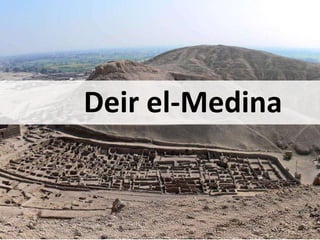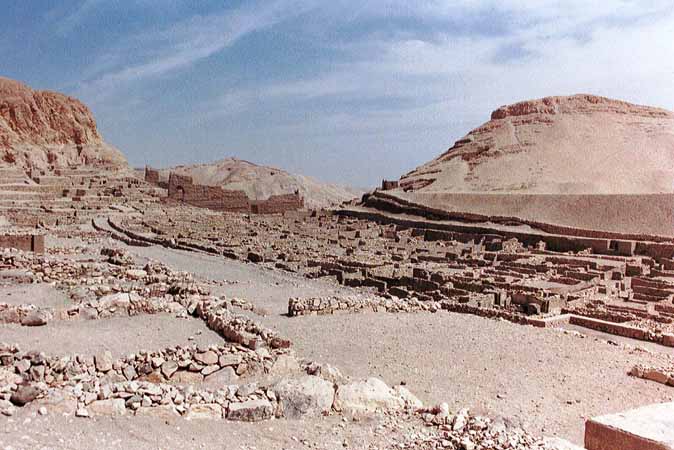Deir el-Medina: Secrets of Egypt's Enigmatic Village

Welcome to the enigmatic village of Deir el-Medina, nestled in the breathtaking landscape of ancient Egypt. Prepare to be transported back in time as you explore the secrets and mysteries that lie within this remarkable archaeological site.
Introduction to Deir el-Medina
Imagine walking through the narrow streets of a village once home to the artisans and labourers who built the tombs of the pharaohs in the Valley of the Kings. This is Deir el-Medina, the "Village of the Workers." Located on the west bank of the Nile, near the modern city of Luxor, it flourished during the New Kingdom period, roughly from the 16th century BCE to the 11th century BCE.
Historical significance of Deir el-Medina
Deir el-Medina holds great historical significance because it offers us a rare glimpse into the daily lives of the ancient Egyptians. Deir el-Medina was remarkably well-preserved, unlike other ancient settlements mainly untouched. Excavations conducted in the early 20th century unearthed a wealth of information about the village and its inhabitants.
The village was home to the skilled artisans who worked on the tombs in the nearby Valley of the Kings. They were responsible for creating the elaborate paintings and carvings that adorned the final resting places of the pharaohs. These artisans lived in tightly knit communities, working together and relying on each other for support.
One of the most intriguing aspects of Deir el-Medina is the discovery of personal letters and documents that provide insight into the everyday concerns and emotions of the villagers. These documents highlight the social structure, family dynamics, and even personal disputes that were part of life in this ancient society.
But perhaps the most fascinating aspect of Deir el-Medina is the sense of community and shared purpose that permeated every aspect of life in the village. The villagers worked together as a close-knit community, supporting each other and relying on their unique skills to create something extraordinary.
So, if you yearn to uncover ancient Egypt's secrets and delve into its ordinary people's lives, a visit to Deir el-Medina is a must. Experience the magic and wonder of this mysterious village and let the history and stories of the past come alive before your

Life in Deir el-Medina
Daily life and routines in the village
Welcome to Deir el-Medina, an enigmatic village nestled in ancient Egypt. Here, you will uncover the secrets of daily life and routines within its walls.
As you step back, you will find that Deir el-Medina was a unique community. It was home to the craftsmen who worked on the tombs in the nearby Valley of the Kings. The village had its infrastructure and was self-sufficient. The residents, known as the "Servants in the Place of Truth," led a structured and fascinating existence.
In this tightly-knit community, daily life revolved around work and family. The craftsmen had a rigorous routine. They would wake up early in the morning and gather at the workshop, receiving instructions and materials for the day. The tasks ranged from carving hieroglyphics to creating intricate art on tomb walls. The craftsmen worked diligently, displaying incredible skill and precision.
Outside work, the villagers engaged in various activities to relax and unwind. They enjoyed music, dancing, and storytelling, often gathering in communal areas or their homes. The village also had a spiritual side, with regular visits to temples and offerings to the gods.
Roles and responsibilities of the craftsmen and their families
The craftsmen and their families played critical roles in the functioning of the village. The craftsmen, known for their elite skills, were highly regarded and respected by the pharaoh and the people of Egypt. They were responsible for preserving and decorating the tombs of the royals and nobles.
Their families had a vital role in supporting their work. The women and children helped prepare the materials, such as mixing pigments for paintings or grinding minerals for pigments. They also produced clothing and food for the craftsmen, ensuring their well-being and allowing them to focus on their intricate tasks.
In addition to their artistic abilities, the craftsmen were also knowledgeable about religious rituals and ceremonies. They participated in religious festivals and were considered guardians of sacred knowledge.
By understanding the daily life and roles of the villagers in Deir el-Medina, we gain insights into the vibrant, tightly-knit community that thrived in this ancient Egyptian village. The craftsmen and their families left a lasting legacy through their exceptional craftsmanship, which can still be admired today in the tombs they worked on.

Deir el-Medina: Secrets of Egypt's Enigmatic Village
Are you fascinated by ancient Egypt and its mysteries? If so, you must explore the secrets of Deir el-Medina, an enigmatic village home to the skilled craftsmen responsible for building the tombs of pharaohs and nobles. Let's uncover the fascinating details behind this historic site.
The skilled craftsmen behind the tombs
In the heart of the scorching desert, the village of Deir el-Medina flourished as the bustling home of skilled artisans. These craftsmen, known as "the chosen ones," were responsible for constructing the splendid tombs of Egyptian royalty and nobles. Their unparalleled craftsmanship adorned the walls of these tombs with intricate paintings, hieroglyphics, and monumental sculptures.
What makes Deir el-Medina truly remarkable is the fact that it was a closed community, isolated from the outside world. This was done to keep the secrets of tomb construction safe from prying eyes. The inhabitants of this village lived a unique lifestyle governed by a sense of duty and reverence for their craft.
Techniques and tools used for tomb construction
Deir el-Medina's craftsmen mastered tomb construction through a combination of skill, knowledge, and sheer dedication. They employed various techniques and tools to create these architectural marvels.
Some techniques used included quarrying and shaping stones, carving and painting hieroglyphics, and sculpting statues. The craftsmen utilized tools such as chisels, hammers, drills, and brushes to meticulously bring the visions of the pharaohs and nobles to life on the walls of the tombs.
The meticulous attention to detail and precision displayed by these artisans is awe-inspiring. Their mastery of various mediums, including paint, wood, and stone, is evident in the incredible preservation of their work, even after thousands of years.
Visiting Deir el-Medina allows you to step back in time and witness the magnificence of Egyptian craftsmanship. It offers a glimpse into these artisans' immense talent and dedication, who worked tirelessly to create everlasting tributes to the pharaohs and nobles of ancient Egypt.
Unearthing the secrets of Deir el-Medina is a journey that transports you to a world of wonder and intrigue. So, pack your bags and embark on an adventure that will immerse you in this remarkable site's rich history and captivating mysteries.

Secrets and Mysteries of Deir el-Medina
Unraveling the secrets hidden within the village
Have you ever wondered about the secrets and mysteries that lie within ancient civilizations? If so, then Deir el-Medina, also known as "The Valley of the Workers," is a place that will fascinate you. Located on the west bank of the Nile in Egypt, this enigmatic village was home to the artisans and craftsmen who constructed the tombs of the pharaohs in the nearby Valley of the Kings.
One of the main secrets of Deir el-Medina is its isolation. The village was strategically positioned away from the main cities of Egypt, with only one entry and exit point. This isolation allowed the inhabitants to keep their knowledge and trade secrets hidden from the outside world. This deliberate separation from society also gave the village a unique and tightly-knit community, with residents living and working together for generations.
Another mystery revolves around the complex and intricate tombs the artisans built. These tombs, such as the famous Tomb of Sennedjem, are adorned with detailed paintings and hieroglyphics, offering a glimpse into the lives and beliefs of the inhabitants. It is believed that the workers of Deir el-Medina held a special status in society and had a close relationship with the pharaohs.
Speculations and theories about the purpose of these secrets
Over the years, scholars and archaeologists have put forth various theories about the purpose and significance of the secrets hidden within Deir el-Medina. Some believe that the isolation and secrecy were necessary to protect the village's valuable assets and trade secrets. In contrast, others speculate that it was a means of preserving the religious and magical practices of the craftsmen.
Another interesting theory suggests that the tombs were not just a final resting place for the artisans but also served as a form of communication with the gods. The intricate depictions and hieroglyphics on the walls of the tombs may have been meant to guide the spirits of the deceased to the afterlife and ensure their eternal protection.
While we may never fully uncover Deir el-Medina's secrets, its enigmatic nature continues to intrigue and captivate researchers and visitors alike. Exploring this ancient village allows us to glimpse the lives and beliefs of the skilled craftsmen who played a vital role in Egypt's rich history.

Unique artistic styles and masterpieces found in the village
When you visit Deir el-Medina, you will be captivated by its unique and exquisite artistic style. This ancient Egyptian village, located on the West Bank of the Nile near Luxor, was home to the craftsmen and artisans who built and decorated the tombs in the nearby Valley of the Kings. The walls of the tombs and houses in Deir el-Medina are adorned with stunning and intricate paintings, showcasing the incredible skill of the artists who lived there.
One of the masterpieces found in the village is the Tomb of Sennedjem, a tomb belonging to an ancient Egyptian artist. The walls of this tomb are covered with beautiful scenes depicting everyday life, religious rituals, and the afterlife. These paintings' attention to detail and vibrant colours are truly remarkable.
The significance of art in the daily lives of the residents
Art played a significant role in the residents' daily lives of Deir el-Medina. The artists and craftsmen in the village were highly respected and valued for their skills. They not only decorated the tombs of the pharaohs but also created exquisite jewellery, pottery, and other artistic objects.
Art was also an important form of religious expression in ancient Egypt, and the residents of Deir el-Medina captured the essence of their beliefs and rituals in their art. The paintings and decorations in the tombs served as a means to ensure a successful journey into the afterlife for the deceased.
In addition to its religious and cultural significance, art also provided a means of documenting history and preserving stories for future generations. The scenes depicted in the tomb paintings and other artistic creations offer a valuable glimpse into the daily lives and customs of the people who lived in Deir el-Medina over three thousand years ago.
Visiting Deir el-Medina is like stepping back in time and immersing yourself in the rich artistic heritage of ancient Egypt. The masterpieces in this enigmatic village give us a glimpse into the creativity and genius of the people who lived there, making it a must-visit destination for any art and history lover.
Legacy of Deir el-Medina
Influence of Deir el-Medina on ancient Egyptian history
If you are fascinated by ancient Egypt, then the enigmatic village of Deir el-Medina is a place you must explore. Situated on the west bank of the Nile River, near modern-day Luxor, this hidden gem offers a glimpse into the daily lives of the workers who built the tombs in the nearby Valley of the Kings.
Preservation efforts and current archaeological research
We can learn more about this unique village thanks to ongoing preservation efforts and archaeological research. Excavations have uncovered beautifully decorated houses, ornate tombs, and even a temple dedicated to the goddess Hathor. The village flourished for over four centuries, from the 15th to the 12th century BCE, and was home to a community of highly skilled craftsmen, artists, and labourers who worked on the royal tombs.
One of the most intriguing aspects of Deir el-Medina is the level of organization and social structure within the village. The workers and their families lived in tightly-knit communities with clear hierarchies and designated roles. They had their judicial system and a council that resolved disputes and governed the village.
The walls of the houses in Deir el-Medina are adorned with exquisite murals that depict everyday life, religious rituals, and scenes of the afterlife. These paintings offer valuable insights into the beliefs and customs of the ancient Egyptians.
Today, ongoing excavations and research at Deir el-Medina continue to uncover discoveries. Archaeologists have found ancient tools, papyri with legal and administrative documents, and even personal belongings of the inhabitants. These artefacts provide valuable clues about the lives of the people who once called this village home.
By visiting Deir el-Medina, you will witness the incredible craftsmanship and artistry of the ancient Egyptians and gain a deeper understanding of their daily lives, beliefs, and social structure. It is truly a place where history comes alive and where you can touch the legacy of one of the greatest civilizations in human history.
